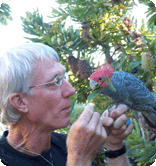Safely fledging Budgies

Hi EB, I have a pair of budgies that probably were cliped before fledging. They are now about 6 months old and feathers are fully grown in. Please give advice on how to help them fledge safely at this point.
Thanks, Jeffrey

Dear Jeffrey, As your budgerigars are still quite young, it should not be too difficult to accomplish their first flying training.
Once their flight feathers are all grown out, you can encourage them to begin flapping on your finger or on a stick by raising and lowering the stick to get them to begin feeling their wing downbeats supporting their body weight.
Flight training is all about landing skills, so you need to teach them to land competently. This we accomplish on the master bed where the bird can be encouraged to fly six or eight inches at first down to the soft surface—learning through repetition to brake with its wings, put out its feet and look downward to a feet-first landing. Make sure you do not allow them to over-flap and fly a long distance to crash to the floor. Such mistakes ruin their progress and make them fearful of bumps and bruises.
From there you can progress to getting them to take longer two, three, four-foot flights to build up confidence on the soft surface. Once they get that down, a folded bath towel on top of their cage or the couch back, etc. can be another landing site.
Flying to a perch can take place a bit later as it is a more precise skill and can involve a harder landing on the feet and leg muscles.
You will know when they are flying better because most parrots begin to increase their speed. Make sure they learn to fly down, turn left and right and return, and of course are able to adjust and fly after a bath when still wet. Feel free to contact me with any specific questions about your pets’ fledging.
Cheers, EB

































